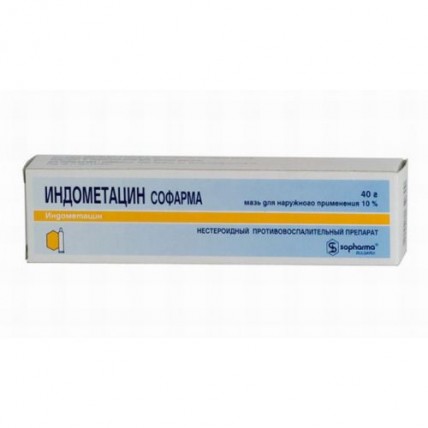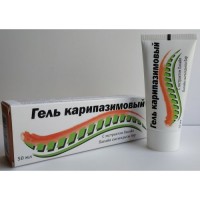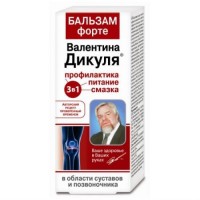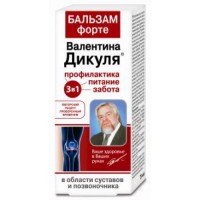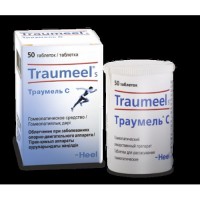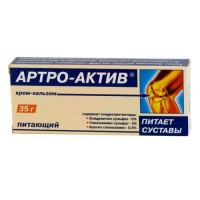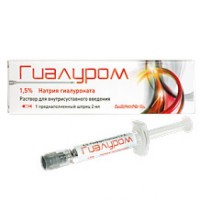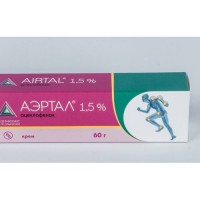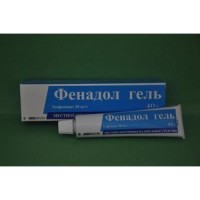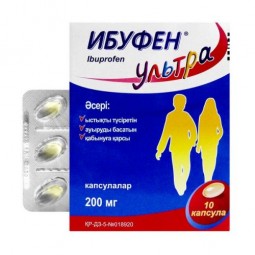Indomethacin-Sopharma 10% 40g ointment tube
- $2.80
The instruction for medical use
of medicine
Sopharm Indometacin
the Trade name
Sopharm Indometacin
the International unlicensed
name Indometacin Dosage Form 10% Ointment Structure of 100 G of Ointment is contained:
active agent: indometacin of 100 mg,
excipients: lanolin, paraffin white soft (vaseline white), dimethyl sulfoxide, yellow beeswax, silicon dioxide colloidal anhydrous, oil lavender.
The description
Homogeneous ointment of yellow color, with a specific smell.
Pharmacotherapeutic group
Drugs for topical treatment of diseases of the musculoskeletal system. Non-steroidal anti-inflammatory drugs for topical administration. Indometacin.
The ATX M02AA23 code
the Pharmacological
Pharmacokinetics Dosage Form properties – ointment allows fast penetration of active agent through skin and fast achievement of local therapeutic concentration in the subject soft tissues, joints and synovial fluid.
At system use of indometacin:
Absorption
of Rezorbiruyetsya substantially from digestive tract. The maximum plasma concentration is reached in 1-2 hours after reception.
Distribution
Is distributed in all fabrics and bodies. Also the blood-brain barrier gets through placentary. Gets through a synovial membrane into joints, and its concentration in synovial fluid is higher, than in plasma. Contacts plasma proteins in 90-98% and has ability to force out other medicines from communication with proteins and to enhance their therapeutic effect at simultaneous use.
Metabolism
Is metabolized generally in a liver by oxidation and conjugation.
Removal
Elimination half-life of indometacin varies from 2.6 to 11.2 h or it averages 5.8 hours. It is allocated through kidneys in 60-75% (10-20% from them in not changed look), and other quantity is distinguished with bile and a stake. It is allocated with breast milk, though in insignificant quantities.
The pharmacodynamics
Ointment of indometacin has anti-inflammatory and analgeziruyushchy effect.
The mechanism of action is connected with inhibition of activity of cyclooxygenase I and II of types. Indometacin inhibits TsOG-I in comparison with TsOG-II an enzyme isoform stronger (the index of selectivity TsOG-I: TsOG-II = 22.3 - 33.0). Disturbance of activity of TsOG-I provides the best elimination of a sharp pain syndrome whereas blockade of TsOG-II is related to perception of chronic pain. As a result of blockade of COG, reactions of an arachidonic cascade of synthesis of eicosanoids and formation of prostaglandins PgE2, PgF2a, TxA2 thromboxane, PgI2 prostacyclin are broken. In bólshey degrees, than when using other means, synthesis of PgF2a is broken. Suppresses activation of NF-kB – a factor of a transcription of genes which is necessary for synthesis of a number of inflammatory cytokines (IL-1,6,8, TNF-a) and molecules of cellular adhesion (ICAM-1, VCAM-1). For lack of synthesis of these cytokines the activity of chronic inflammatory process is suppressed. Indometacin contacts NO-SYNTHASE and breaks products NOB result in a cell NO - dependent synthesis of the new molecules TsOG-II and products of prostaglandins decreases.
In rheumatic diseases has anti-inflammatory and analgeziruyushchy effect. Weakens a rest pain and at the movement, reduces morning constraint and a swelling of joints, improves their function. Is one of non-steroidal anti-inflammatory drugs with the most severe anti-inflammatory action. By efficiency of anti-inflammatory action exceeds acetylsalicylic acid.
The Analgeziruyushchy effect develops in 30-60 min. after applique of ointment and remains within 6-9 hours, the maximum action is noted 2-3 hours later after applique. The Analgeziruyushchy effect of indometacin is shown irrespective of its anti-inflammatory action and is connected only with the pain caused by damage of fabric or inflammatory process.
Indications
- an additional tool in complex therapy of an acute and chronic pseudorheumatism, osteoarthritis, osteoarthrosis, ankylosing spondylitis, psoriasis polyarthritis, gouty arthritis
- the localized forms of extraarticular rheumatism of the musculoskeletal system: tendinites, synovites, a tendovaginitis, inflammations of fastion and articulate sheaves, a bursitis
- topical symptomatic treatment of inflammation, pain and hypostasis at posttraumatic defeats of the musculoskeletal system (stretchings, dislocations, bruises).
Route of administration and doses
Route of administration: locally, on skin.
It is recommended to apply local forms of indometacin in complex treatment with solid dosage forms of drug.
Adults and teenagers are more senior than 14 years
Ointment is applied on an affected area by 3-4 times a day, carefully rubbing in skin to its full resorption. The amount of ointment necessary for one drawing depends on the area of defeat and is about 4-5 cm. Interval between use not less than 6 hours.
Children are younger than 14-year age
Use of drug for this age group is not recommended.
Treatment duration: 7-10 days. If for this span of effect it is not noted, treatment should be reconsidered.
Side effects
- burning in the place of use, reddening, an itching, rashes, peeling, xeroderma.
Seldom-seater hypostasis, vesicular rash, a Quincke's disease, suffocation
- loss of appetite, nausea, vomiting, diarrhea, pain, hemorrhages and ulcerations
(at use on the big surfaces of skin).
Probability of emergence of systemic side effects at topical administration of indometacin is small in comparison with the frequency of side effects at oral administration.
Contraindications
- hypersensitivity to active or to any of auxiliary components of drug
- hypersensitivity to acetylsalicylic acid or other non-steroidal anti-inflammatory drugs with clinical manifestation of an asthmatic attack, urticaria or allergic rhinitis
- pregnancy and the period of a lactation
- children's age up to 14 years
- open wounds, the infected skin
Medicinal interactions
At topical administration of indometacin because of the minimum resorption, interaction with other medicines are a little probable.
Simultaneous use of indometacin with other medicine from the NPVS group, including selection TsOG-2 inhibitors, should be avoided because of increase in risk of side effects.
Simultaneous use of indometacin with aspirin or corticosteroids increases risk of gastrointestinal complications.
Non-steroidal anti-inflammatory drugs can interact with the medicines lowering arterial blood pressure though such opportunity at topical administration is exclusively small.
Intake of non-steroidal anti-inflammatory drugs can
Sometimes lead special instructions to gastrointestinal tract diseases, deterioration in warm function at patients with cardiovascular insufficiency, disturbances of blood clotting (including hemophilia, lengthening of a bleeding time, tendency to bleedings), to disturbance of hepatic and renal functions (including aggravation of a hepatic porphyria). In spite of the fact that after local drawing on skin systemic action of indometacin minimum, the patients with active ulcer of stomach or duodenum having renal diseases or heart failure in the anamnesis as well as elderly patients have to carry out treatment mazyu with indometacin only after consultation with the doctor.
The Indometacin drug treatment, ointment of 10% is carried out with extra care and after consultation with the doctor at patients with manifestations of hypersensitivity to foodstuff and medicines or with allergic diseases – senny cold, bronchial asthma, a recurrent polypose of a nose and near-nasal bosoms.
There is a cross hypersensitivity to other NPVS therefore patients with manifestations of hypersensitivity in the past to any drugs from this group, can have manifestations of hypersensitivity and to indometacin.
At long-term treatment (more than 10 days) the laboratory control of quantity of leukocytes and thrombocytes is recommended.
It is possible to apply drug only to the healthy, uninjured skin (in the absence of open wounds and damages). It is impossible to apply on mucous membranes and in eyes.
At appearance of rash after topical administration the treatment should be stopped immediately.
As a part of drug the dimethyl sulfoxide which can render irritant action on skin contains.
As a part of drug lanolin which can render irritant action on skin (contact dermatitis) contains.
Pregnancy and the period of a lactation
Pregnancy
were not carried out the controlled clinical trials at pregnant women therefore use of indometacin during pregnancy is not recommended.
Breastfeeding
Is allocated in small amounts with breast milk therefore drug is not recommended to the nursing women.
The feature of influence of medicine on ability to run the vehicle or potentially dangerous mechanisms
does not affect ability to driving and work with moving mechanisms.
The overdose
At topical administration overdose is a little probable because of a weak system resorption. The overdose phenomena (generally from a digestive tract) can be observed very seldom, only at long drawing on the big surfaces of skin.
Symptoms at intake: burning of a mucous membrane of an oral cavity, salivation, nausea, vomiting.
Treatment: washing of an oral cavity and stomach, if necessary - symptomatic treatment.
There is no specific antidote.
Symptoms at hit in eyes, on mucous membranes or open wounds: the local irritation – dacryagogue, reddening, burning, pain is observed.
Treatment: plentiful washing of an affected area the distilled water or normal saline solution before reduction and disappearance of complaints.
The form of release and packing
On 40 g of drug place in a membrane tuba aluminum, from within varnished by harmless varnish, with the screw-on cap from polypropylene.
On 1 tuba together with the instruction for medical use in the state and Russian languages place in a pack from the cardboard covered on the one hand with a pigment.
To Store storage conditions in original packing at a temperature not higher than 25 wasps.
To store out of children's reach!
Period of storage
3 years.
A period of storage after opening of a tuba: 1 month
not to use drug after an expiration date.
Prescription status
Without prescription
JSC Sopharm Producer
Iliyenskoye Highway St. 16, 1220 Sofia, Bulgaria
the Owner of the registration certificate
of JSC Sopharm, Bulgaria
the Address of the organization accepting in the territory of the Republic of Kazakhstan claims from consumers on quality of products (goods):
JSC Sopharm the Trade mission in Almaty, Kazakhstan, 050036, mdt. "Mamyr 4", 190
Phone number: 7 (727) 380 01 03, 380 01 37, 380 01 42 (vn. 108)
Fax number: 7 (727) 381 63 86
E-mail address:
To Develop info@sopharma.kz
of medicine
Sopharm Indometacin
the Trade name
Sopharm Indometacin
the International unlicensed
name Indometacin Dosage Form 10% Ointment Structure of 100 G of Ointment is contained:
active agent: indometacin of 100 mg,
excipients: lanolin, paraffin white soft (vaseline white), dimethyl sulfoxide, yellow beeswax, silicon dioxide colloidal anhydrous, oil lavender.
The description
Homogeneous ointment of yellow color, with a specific smell.
Pharmacotherapeutic group
Drugs for topical treatment of diseases of the musculoskeletal system. Non-steroidal anti-inflammatory drugs for topical administration. Indometacin.
The ATX M02AA23 code
the Pharmacological
Pharmacokinetics Dosage Form properties – ointment allows fast penetration of active agent through skin and fast achievement of local therapeutic concentration in the subject soft tissues, joints and synovial fluid.
At system use of indometacin:
Absorption
of Rezorbiruyetsya substantially from digestive tract. The maximum plasma concentration is reached in 1-2 hours after reception.
Distribution
Is distributed in all fabrics and bodies. Also the blood-brain barrier gets through placentary. Gets through a synovial membrane into joints, and its concentration in synovial fluid is higher, than in plasma. Contacts plasma proteins in 90-98% and has ability to force out other medicines from communication with proteins and to enhance their therapeutic effect at simultaneous use.
Metabolism
Is metabolized generally in a liver by oxidation and conjugation.
Removal
Elimination half-life of indometacin varies from 2.6 to 11.2 h or it averages 5.8 hours. It is allocated through kidneys in 60-75% (10-20% from them in not changed look), and other quantity is distinguished with bile and a stake. It is allocated with breast milk, though in insignificant quantities.
The pharmacodynamics
Ointment of indometacin has anti-inflammatory and analgeziruyushchy effect.
The mechanism of action is connected with inhibition of activity of cyclooxygenase I and II of types. Indometacin inhibits TsOG-I in comparison with TsOG-II an enzyme isoform stronger (the index of selectivity TsOG-I: TsOG-II = 22.3 - 33.0). Disturbance of activity of TsOG-I provides the best elimination of a sharp pain syndrome whereas blockade of TsOG-II is related to perception of chronic pain. As a result of blockade of COG, reactions of an arachidonic cascade of synthesis of eicosanoids and formation of prostaglandins PgE2, PgF2a, TxA2 thromboxane, PgI2 prostacyclin are broken. In bólshey degrees, than when using other means, synthesis of PgF2a is broken. Suppresses activation of NF-kB – a factor of a transcription of genes which is necessary for synthesis of a number of inflammatory cytokines (IL-1,6,8, TNF-a) and molecules of cellular adhesion (ICAM-1, VCAM-1). For lack of synthesis of these cytokines the activity of chronic inflammatory process is suppressed. Indometacin contacts NO-SYNTHASE and breaks products NOB result in a cell NO - dependent synthesis of the new molecules TsOG-II and products of prostaglandins decreases.
In rheumatic diseases has anti-inflammatory and analgeziruyushchy effect. Weakens a rest pain and at the movement, reduces morning constraint and a swelling of joints, improves their function. Is one of non-steroidal anti-inflammatory drugs with the most severe anti-inflammatory action. By efficiency of anti-inflammatory action exceeds acetylsalicylic acid.
The Analgeziruyushchy effect develops in 30-60 min. after applique of ointment and remains within 6-9 hours, the maximum action is noted 2-3 hours later after applique. The Analgeziruyushchy effect of indometacin is shown irrespective of its anti-inflammatory action and is connected only with the pain caused by damage of fabric or inflammatory process.
Indications
- an additional tool in complex therapy of an acute and chronic pseudorheumatism, osteoarthritis, osteoarthrosis, ankylosing spondylitis, psoriasis polyarthritis, gouty arthritis
- the localized forms of extraarticular rheumatism of the musculoskeletal system: tendinites, synovites, a tendovaginitis, inflammations of fastion and articulate sheaves, a bursitis
- topical symptomatic treatment of inflammation, pain and hypostasis at posttraumatic defeats of the musculoskeletal system (stretchings, dislocations, bruises).
Route of administration and doses
Route of administration: locally, on skin.
It is recommended to apply local forms of indometacin in complex treatment with solid dosage forms of drug.
Adults and teenagers are more senior than 14 years
Ointment is applied on an affected area by 3-4 times a day, carefully rubbing in skin to its full resorption. The amount of ointment necessary for one drawing depends on the area of defeat and is about 4-5 cm. Interval between use not less than 6 hours.
Children are younger than 14-year age
Use of drug for this age group is not recommended.
Treatment duration: 7-10 days. If for this span of effect it is not noted, treatment should be reconsidered.
Side effects
- burning in the place of use, reddening, an itching, rashes, peeling, xeroderma.
Seldom-seater hypostasis, vesicular rash, a Quincke's disease, suffocation
- loss of appetite, nausea, vomiting, diarrhea, pain, hemorrhages and ulcerations
(at use on the big surfaces of skin).
Probability of emergence of systemic side effects at topical administration of indometacin is small in comparison with the frequency of side effects at oral administration.
Contraindications
- hypersensitivity to active or to any of auxiliary components of drug
- hypersensitivity to acetylsalicylic acid or other non-steroidal anti-inflammatory drugs with clinical manifestation of an asthmatic attack, urticaria or allergic rhinitis
- pregnancy and the period of a lactation
- children's age up to 14 years
- open wounds, the infected skin
Medicinal interactions
At topical administration of indometacin because of the minimum resorption, interaction with other medicines are a little probable.
Simultaneous use of indometacin with other medicine from the NPVS group, including selection TsOG-2 inhibitors, should be avoided because of increase in risk of side effects.
Simultaneous use of indometacin with aspirin or corticosteroids increases risk of gastrointestinal complications.
Non-steroidal anti-inflammatory drugs can interact with the medicines lowering arterial blood pressure though such opportunity at topical administration is exclusively small.
Intake of non-steroidal anti-inflammatory drugs can
Sometimes lead special instructions to gastrointestinal tract diseases, deterioration in warm function at patients with cardiovascular insufficiency, disturbances of blood clotting (including hemophilia, lengthening of a bleeding time, tendency to bleedings), to disturbance of hepatic and renal functions (including aggravation of a hepatic porphyria). In spite of the fact that after local drawing on skin systemic action of indometacin minimum, the patients with active ulcer of stomach or duodenum having renal diseases or heart failure in the anamnesis as well as elderly patients have to carry out treatment mazyu with indometacin only after consultation with the doctor.
The Indometacin drug treatment, ointment of 10% is carried out with extra care and after consultation with the doctor at patients with manifestations of hypersensitivity to foodstuff and medicines or with allergic diseases – senny cold, bronchial asthma, a recurrent polypose of a nose and near-nasal bosoms.
There is a cross hypersensitivity to other NPVS therefore patients with manifestations of hypersensitivity in the past to any drugs from this group, can have manifestations of hypersensitivity and to indometacin.
At long-term treatment (more than 10 days) the laboratory control of quantity of leukocytes and thrombocytes is recommended.
It is possible to apply drug only to the healthy, uninjured skin (in the absence of open wounds and damages). It is impossible to apply on mucous membranes and in eyes.
At appearance of rash after topical administration the treatment should be stopped immediately.
As a part of drug the dimethyl sulfoxide which can render irritant action on skin contains.
As a part of drug lanolin which can render irritant action on skin (contact dermatitis) contains.
Pregnancy and the period of a lactation
Pregnancy
were not carried out the controlled clinical trials at pregnant women therefore use of indometacin during pregnancy is not recommended.
Breastfeeding
Is allocated in small amounts with breast milk therefore drug is not recommended to the nursing women.
The feature of influence of medicine on ability to run the vehicle or potentially dangerous mechanisms
does not affect ability to driving and work with moving mechanisms.
The overdose
At topical administration overdose is a little probable because of a weak system resorption. The overdose phenomena (generally from a digestive tract) can be observed very seldom, only at long drawing on the big surfaces of skin.
Symptoms at intake: burning of a mucous membrane of an oral cavity, salivation, nausea, vomiting.
Treatment: washing of an oral cavity and stomach, if necessary - symptomatic treatment.
There is no specific antidote.
Symptoms at hit in eyes, on mucous membranes or open wounds: the local irritation – dacryagogue, reddening, burning, pain is observed.
Treatment: plentiful washing of an affected area the distilled water or normal saline solution before reduction and disappearance of complaints.
The form of release and packing
On 40 g of drug place in a membrane tuba aluminum, from within varnished by harmless varnish, with the screw-on cap from polypropylene.
On 1 tuba together with the instruction for medical use in the state and Russian languages place in a pack from the cardboard covered on the one hand with a pigment.
To Store storage conditions in original packing at a temperature not higher than 25 wasps.
To store out of children's reach!
Period of storage
3 years.
A period of storage after opening of a tuba: 1 month
not to use drug after an expiration date.
Prescription status
Without prescription
JSC Sopharm Producer
Iliyenskoye Highway St. 16, 1220 Sofia, Bulgaria
the Owner of the registration certificate
of JSC Sopharm, Bulgaria
the Address of the organization accepting in the territory of the Republic of Kazakhstan claims from consumers on quality of products (goods):
JSC Sopharm the Trade mission in Almaty, Kazakhstan, 050036, mdt. "Mamyr 4", 190
Phone number: 7 (727) 380 01 03, 380 01 37, 380 01 42 (vn. 108)
Fax number: 7 (727) 381 63 86
E-mail address:
To Develop info@sopharma.kz
